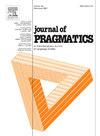Phrasal or clausal grammatical formats of instructions in a boxing ‘mitt-hitting’ activity
IF 1.7
1区 文学
0 LANGUAGE & LINGUISTICS
引用次数: 0
Abstract
This paper shows how short or longer formats of instruction (i.e. phrases, clauses, or multi-unit turns) emerge in the face-to-face boxing activity of ‘mitt-hitting’: a coach presents a mitt as a target with verbal instructions and the instructed boxer hits it, as they practice one type of punch after another. In this activity, different turn-sizes in the coach's verbal instruction, (e.g. phrases, clauses, or multi-unit turns) are tied to whether or not the participants orient to immediate initiation of the targeted punch proper around when the coach's mitt position is complete and ready. When the participants orient to immediate initiation of the targeted punch proper upon the completed target, the coach's verbal instructions are often short, e.g. noun phrases. In contrast, the instruction formats can be clauses or multi-unit turns, in addition to phrases, when the participant(s) walk or step before the initiation of the punch proper and thus orient to the non-immediacy of initiation of the punch proper vis-à-vis the completed targets. Their walking or stepping allows the coach to produce those longer formats before the punch initiation. Thus, based on multimodal analyses of embodied activity, this study shows that grammatical units are inseparable from the multiple participants' moving bodies, which are directed as a gestalt toward the local implementation of punch initiations.
短语或小句语法格式的指令在拳击‘拳击’活动
本文展示了短格式或长格式的指导(即短语,从句或多单元回合)如何出现在面对面的拳击“打手套”活动中:教练以口头指示呈现手套作为目标,受指导的拳击手击打它,因为他们练习一种接一种的击打。在这个活动中,教练口头指导中的不同回合大小(例如短语,从句或多单元回合)与参与者是否在教练的手套位置完成并准备好后立即开始目标击打有关。当参与者倾向于在完成目标后立即开始有针对性的打击时,教练的口头指示通常很短,例如名词短语。相比之下,指令格式可以是从句或多单元转弯,除了短语,当参与者(s)走或步之前的击打适当,从而定位于非立即发起的击打适当相对-à-vis完成的目标。他们的走路或踏步可以让教练在打拳开始前产生那些较长的格式。因此,基于对具身活动的多模态分析,本研究表明,语法单位与多个参与者的运动身体是分不开的,这些运动身体作为一种格式塔,指向局部实施打孔发起。
本文章由计算机程序翻译,如有差异,请以英文原文为准。
求助全文
约1分钟内获得全文
求助全文
来源期刊

Journal of Pragmatics
Multiple-
CiteScore
3.90
自引率
18.80%
发文量
219
期刊介绍:
Since 1977, the Journal of Pragmatics has provided a forum for bringing together a wide range of research in pragmatics, including cognitive pragmatics, corpus pragmatics, experimental pragmatics, historical pragmatics, interpersonal pragmatics, multimodal pragmatics, sociopragmatics, theoretical pragmatics and related fields. Our aim is to publish innovative pragmatic scholarship from all perspectives, which contributes to theories of how speakers produce and interpret language in different contexts drawing on attested data from a wide range of languages/cultures in different parts of the world. The Journal of Pragmatics also encourages work that uses attested language data to explore the relationship between pragmatics and neighbouring research areas such as semantics, discourse analysis, conversation analysis and ethnomethodology, interactional linguistics, sociolinguistics, linguistic anthropology, media studies, psychology, sociology, and the philosophy of language. Alongside full-length articles, discussion notes and book reviews, the journal welcomes proposals for high quality special issues in all areas of pragmatics which make a significant contribution to a topical or developing area at the cutting-edge of research.
 求助内容:
求助内容: 应助结果提醒方式:
应助结果提醒方式:


